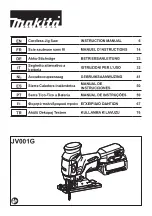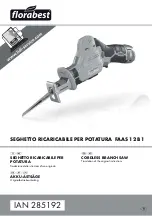
www.scheppach.com
+(49)-08223-4002-99
+(49)-08223-4002-58
17 І 56
7. Additional safety instructions for all
saws
Causes and prevention of kickbacks:
• A kickback is a sudden reaction due to a caught, jam-
med or incorrectly adjusted saw blade, which leads
to the saw rearing up in an uncontrolled manner and
moving out of the work piece towards the operator.
• If a saw blade catches or jams in the sawing edge that
closes behind it, it is blocked and motor’s drive pushes
the saw back in the direction of the operator.
• If the saw blade twists in the saw groove or is incor-
rectly positioned, the teeth at the rear side of the saw
blade edge catch in the surface of the work piece. The
saw then moves out of the saw groove and springs
back in the direction of the operator.
• A kickback results from an incorrect or faulty use of the
saw. It can be prevented, as will be described in the
following, by appropriate cautionary measures.
a) Hold onto the saw and position your arms so that they
can absorb any energy from a kickback. Always keep to
the side of the saw blade, and never bring it into line with
your body. In the case of a kickback, the circular saw can
jump backwards, but with adequate caution the operator
can deal with the energy of the kickback.
b) If the saw blade jams or you want to interrupt your
work, then turn the saw off and keep the work piece still
until the saw blade comes to a full stop. Never try to re-
move the saw from the work piece or pull it out when the
saw blade is moving since then a kickback can occur.
Find out the cause of the jam and remove it.
c) If you want to start up a saw that is in the work piece,
centre the saw blade in the sawed groove and check that
the saw blade teeth are not caught in the work piece.
If the saw blade is jammed, it can jump out of the work
piece or cause a kick back when it is started up.
d) Support larger work pieces in order to reduce the risk
of a kick back due to a saw blade jam. The weight of lar-
ger work pieces can cause them to bend. Large pieces
must be supported on both sides, both near the sawing
slot as well as on the edges.
e) Do not use dull or damaged saw blades. Saw blades
with dull or misaligned teeth increase the friction, in the
sawing slot, cause saw blade jams and kickbacks.
f) Before you start sawing, tighten the adjustments for
the cut depth and angles. If you change settings while
sawing, the saw blade can jam and a kickback is the
result.
g) Be particularly careful when making “inserted cuts” in
walls that already exist or other areas where you cannot
see what is behind the surface. When the saw blade is
inserted into the wall it can be blocked by hidden objects
and cause a kick back.
d) Store power tools that are not in use out of reach of
children. Do not let anyone use the tool who does not
have experience with it, or who has not read these ins-
tructions. Power tools can be dangerous when they are
used by inexperienced people.
e) Take good care of your power tools. Make sure that
movable parts function properly and do not jam, see
that parts which influence the use of the machine are
not broken or damaged. Repair damaged parts before
operating the tool. Many accidents are caused by poorly
maintained power tools.
f) Keep cutting edges sharp and clean. Properly maintai-
ned cutting tools with sharp cutting edges jam less often
and are easier to control.
g) Use power tools, accessories, and equipment accor-
ding to these instructions. Taking into account the wor-
king conditions and the work being performed.
The use of power tools other than those intended for the
tool itself can lead to dangerous situations.
5) Service
a) Only let qualified service personnel repair your tool
and always use original replacement parts. This guaran-
tees that the power tool remains safe to use.
6. Safety instructions for all saws
a) DANGER: Do not put your hands in the sawing area
or on the saw blade.
b) Do not put your hands under the work piece. The
protective cap cannot protect your hands from the blade
when they are under the work piece.
c) Adjust the cutting depth to the thickness of the work
piece. Less than one complete sawing tooth should be
visible under the work piece.
d) Never hold the work piece that is to be sawn in your
hand or over your leg. Make sure that the work piece
has a stable balance. It is important that the work piece
is held securely, in order to minimize the danger of con-
tact of a body part with the saw, loss of control over the
saw, or jamming of the blade.
e) Hold the equipment on the insulated handles, when
you undertake work in which the tool being used could
come into contact with hidden electrical wires, or its own
cable. Contact with a live power source can electrify the
metal parts of the tool and lead to an electrical shock.
f) When making a long cut, always use a stop chock or a
straightedge. This improves the accuracy of the cut and
reduces the chance that the saw blade jams.
g) Always use the correct size of saw blades and make
sure they have the right locating bore (e.g. Star shaped
or round). Saw blades that do not fit the assembly of
the saw do not run correctly and cause loss of control.
h) Never use damaged or incorrect saw blade shims
or screws.
The saw blade shims and screws are designed espe-
cially for your saw, for optimal performance and ope-
rating safety.
GB
















































